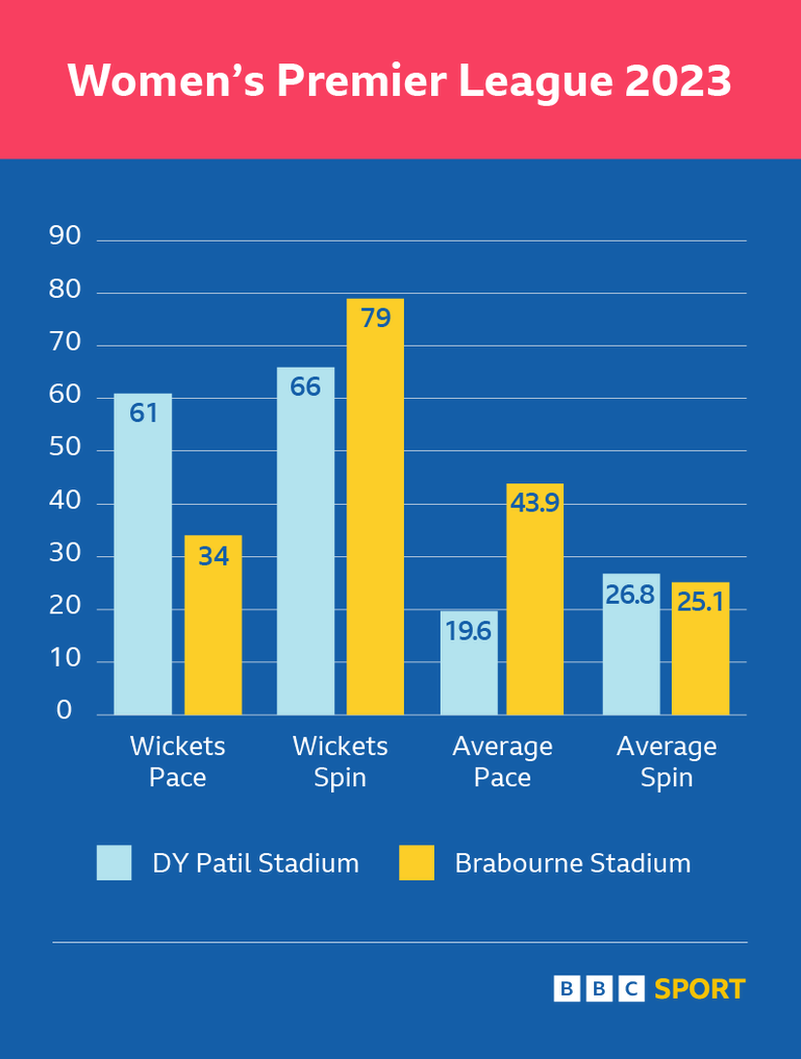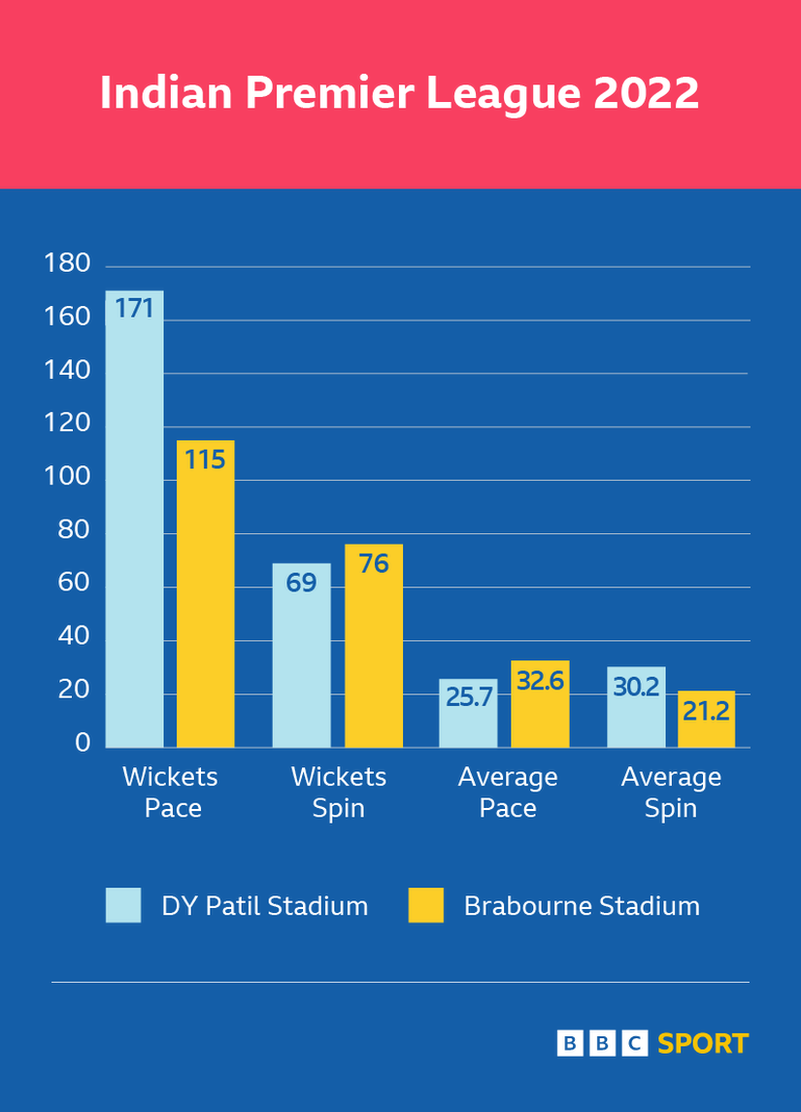India vs England: Why pace, not spin, may decide women's Test in Mumbai
- Published
- comments

Kate Cross (right) is expected to lead England's pace attack having played seven Tests before
Women's Test: India v England |
|---|
Venue: Dr DY Patil Sports Academy, Mumbai Date: 14-17 December Time: 04:00 GMT |
Coverage: Follow live text updates on the BBC Sport website and app. |
On any tour of India you expect to face a trial by spin.
That is particularly true for England, who showed serious frailties against slower bowling during their home summer.
Australia off-spinner Ash Gardner took 23 wickets in the Women's Ashes, including 12 in the Test match, while England struggled against Sri Lanka's spinners in their T20 series defeat.
Head coach Jon Lewis has since held a spin batting camp in Mumbai and taken his squad to Oman to try and acclimatise to conditions they may face during the four-day Test that starts on Thursday at the Dr DY Patil Sports Academy.
Spin will play a significant part in the game, especially with number-one ranked bowler Sophie Ecclestone in England's side, but could seam and the pace bowlers actually decide the match?
Lewis highlighted the impact of pace at DY Patil during his squad announcement so BBC Sport has worked with data analysts CricViz to look at the numbers involved.
Fewer wickets, but better average in WPL
There has only been one first-class match at the DY Patil Stadium, so we have looked at the games in the Women's Premier League (WPL) in 2023 and the 2022 Indian Premier League (IPL) played on the ground.
There is the caveat that the pitch does not have the time to deteriorate in a T20 game, like in a Test, but pitches are reused frequently in franchise tournaments so spin should play more of a part as it progresses.
The graphic below shows the wickets and average by pace and spin bowlers across the 2023 WPL at the DY Patil Stadium and the Brabourne Stadium, the only two grounds used in the tournament.

While spin still took more wickets at the DY Patil (66 to 61), pace accounted for 48% of wickets. At Brabourne that was down to 30%.
It is bowling average (runs conceded per wickets) where you can really see how tricky pace can be to face at DY Patil.
On average a pace bowler took a wicket every 19.6 runs they conceded, compared to 26.8 by spinners. If you think about that in a Test match and the need to take 20 wickets, that could save a side a significant amount of runs, and - with this game only being four days - potentially time too.
Over the past decade, pitches in India have changed, largely due to the talent pool in the men's team with the likes of Jasprit Bumrah and Mohammed Shami among the world's best, making pace bowling more prominent than it once was.
DY Patil is more effective for pace bowlers, particularly compared to Brabourne, where a pace bowler took a wicket every 43.9 runs and a spinner 25.1.
Pace dominates IPL as DY Patil comes out on top
During the 2022 IPL tournament there were 20 matches played at DY Patil and 16 at Brabourne.
Pace, as it tends to do in men's T20s, dominated at both venues, as illustrated below.

At DY Patil, pace accounted for 71% of wickets. That was down to 60% at Brabourne.
The Wankhede, also in Mumbai, was used for 21 matches in this edition of the tournament. Pace claimed 69% of wickets there.
DY Patil also had the lowest average (25.7) of the three venues for pace bowlers, and came second for spinners, showing that Ecclestone and others will still likely play an important role.
Pace bowlers conceded more runs per over than spinners at all three venues, but at 8.7, DY Patil's was the lowest.
What are England expecting?
Since Lewis became head coach, England have played an aggressive brand of cricket and looked to take the game on.
"It will very much depend on the pitch how we approach the game," Lewis told BBC Sport.
"My expectation is a very good pitch. There is good bounce and carry and there's actually a little bit of lateral movement off the seam.
"It might not be as Indian as you might predict, the turner.
"However, the Indian groundspeople are really skilled and as we've seen with many men's Test matches they can prepare wickets as they like."
Captain Heather Knight said: "I certainly think pace will play a part. During the WPL it was actually quite handy for the seamers, it got a bit of bounce."
What options do both sides have?
England's pace attack is set to be led by Kate Cross, who has played seven Tests before, with Lauren Bell and Lauren Filer also available as frontline options.
All-rounder Nat Sciver-Brunt is fit to bowl again, and those four offer variation with Filer the quickest, Sciver-Brunt able to bowl short and Cross and Bell adept at moving the ball.
"Lauren Filer gives us a real high-pace option which I imagine some of the India girls won't be used to," said Knight. "They won't have faced much pace like that, so that's a really exciting weapon for us to have.
"Our other seamers offer a variety of skills but the conditions will be tough. It's very hot and humid which will affect how I can manage them and how long their spells will be."
Filer and Cross are only in the Test squad - England won the T20 series which precedes the Test 2-1 - and have not played any competitive cricket since September so may be short of match sharpness.
Issy Wong, who impressed for Mumbai Indians in the WPL, is not part of the Test group, as she continues to regain confidence after struggling with her bowling mechanics during the summer.
Renuka Singh Thakur will likely lead India's attack for the first time in a Test. She has troubled England with the moving ball before, including taking seven wickets in last week's T20 series. Pace accounted for 37% of wickets in that series.
Meghna Singh and Pooja Vastrakar - who have played a combined three Tests - are also options, as are the uncapped Titas Sadhu and Shubha Satheesh.
England's options have played in 19 Tests, with all four having played at least once.
Women's Tests are still rare, particularly in India, so for both sides this will largely be a step into the unknown.
The winners will undoubtedly be whichever side adapts quickest, but both pace and spin look set to play a key role.